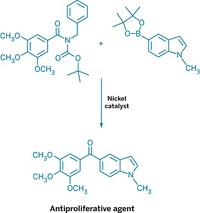Advertisement
Grab your lab coat. Let's get started
Welcome!
Welcome!
Create an account below to get 6 C&EN articles per month, receive newsletters and more - all free.
It seems this is your first time logging in online. Please enter the following information to continue.
As an ACS member you automatically get access to this site. All we need is few more details to create your reading experience.
Not you? Sign in with a different account.
Not you? Sign in with a different account.
ERROR 1
ERROR 1
ERROR 2
ERROR 2
ERROR 2
ERROR 2
ERROR 2
Password and Confirm password must match.
If you have an ACS member number, please enter it here so we can link this account to your membership. (optional)
ERROR 2
ACS values your privacy. By submitting your information, you are gaining access to C&EN and subscribing to our weekly newsletter. We use the information you provide to make your reading experience better, and we will never sell your data to third party members.
Synthesis
Ketenes Finally Give In To Cycloadditions
Compounds finally join list of unsaturated substrates used in transition-metal-catalyzed cycloadditions
by Stephen K. Ritter
May 9, 2011
| A version of this story appeared in
Volume 89, Issue 19
In a chemical first, ketenes have been incorporated into nickel-catalyzed cycloaddition reactions, somehow avoiding decarbonylation of the ketene that has thwarted past attempts (J. Am. Chem. Soc., DOI: 10.1021/ja2007627). Nearly every conceivable unsaturated substrate—alkynes, dienes, carbon dioxide, nitriles, isocyanates, and carbonyls—has been used in transition-metal-catalyzed cycloadditions. But ketenes had been notoriously absent from that list. The reason is not because ketenes are unreactive with typical cycloaddition catalysts, Janis Louie of the University of Utah and coworkers note, but because of the tendency of ketenes to shed their carbonyl groups to form alkenes and unreactive metal-CO complexes. “In view of these pitfalls, we were surprised and delighted to discover that nickel phosphine catalysts mediate the cycloaddition of ketenes and diynes to afford cyclohexadienones in good yields,” they write. The reaction, shown generically, works with an assortment of ketenes and diynes. The team is still hashing out the details of how the reaction avoids decarbonylation, but it stems from selection of the phosphine ligand.





Join the conversation
Contact the reporter
Submit a Letter to the Editor for publication
Engage with us on Twitter